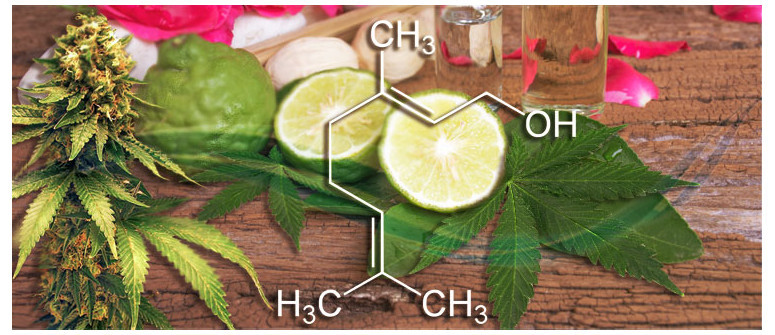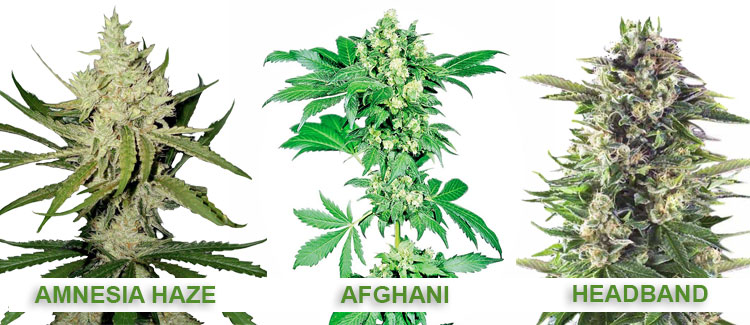Terpene profile: geraniol

Geraniol may be a terpene focus of the future. This molecule, produced by the trichomes of many cannabis strains, has been found to have many therapeutic properties.
To most people who truly love our favorite herb, all cannabis smells great. But you might have noticed that some strains have a very specific smell, and some smell stronger or less than others.
What is actually responsible for these unique smell, is terpenes. Terpenes are aromatic compounds found all throughout nature where they help plants to deter pests and survive. They are responsible for the many signature smells of plant species including that of cannabis.
The main terpene responsible for making some strains smell like sweet and pungent flowers is called geraniol.
WHAT IS GERANIOL?
Geraniol is a terpene that occurs in some strains of cannabis, along with other plant species such as roses, peaches, lemongrass, coriander, geraniums, and lemons. Some of the signature and pleasant scents given off by these plants and fruits are a result of the pungent smell of geraniol.
The highly attractive nature of this terpene has seen its application within commercial industries where it has been added to all matter of products from essential oils, food products, perfumes, and lotions.
Although geraniol smells delightful, the terpene has much more potential than merely serving as a scent. Studies have shown interesting medicinal potential.
WHAT ARE THE EFFECTS AND POSSIBLE MEDICAL BENEFITS OF GERANIOL?

If we go a bit nerdy and dig a bit into what science has been saying about geraniol, there are actually quite a few claims out there.
According to several researches in the past, geraniol has been shown to exhibit anti-viral, anti-inflammatory, antispasmodic, and neuroprotectant properties. The terpene has also shown antioxidant and anti-tumor properties that some say might even lead to possible treatments for cancer in the future.
A 2016 paper published within the International Journal Of Oncology documents the possible antitumor effects of geraniol.[1] The authors of the publication state that the terpene is associated with treating and preventing certain cancers such as breast, lung, colon, prostate, pancreatic, and hepatic cancers.
Geraniol may achieve these effects in several different ways and has been shown to control multiple signaling molecules that are involved in biological processes shown to affect cancer.
According to a research that has already been published in 1988, geraniol has also been shown to possess anti-fungal properties.[2] The study published within the journal Lipids showed that geraniol is capable of inhibiting the growth of both Candida albicans and Saccharomyces, both forms of yeast that are pretty common in the average adult human.
The terpene managed to achieve these effects by enhancing the rate of potassium leakage out of cells and by increasing membrane fluidity. These outcomes led researchers to conclude that geraniol may have potential use as an antifungal agent.
According to a research from 2015, geraniol has also demonstrated anti-inflammatory properties.[3] A 2015 paper published within the European Journal of Pharmacology found that geraniol reduces fibrosis, the thickening and scarring of connective tissue that usually arises due to injury. It was also found that the terpene exerted anti-inflammatory effects against atherogenesis, a disorder of the arterial wall, that was induced by diet.
Geraniol is also being explored as a neuroprotectant, which might be great news for people who suffer from neuropathy — damage to certain parts of the nervous system that can result in symptoms such as numbness, tingling, and pain. It’s also enough to excite biohackers and nootropic fanatics who are always searching for ways to delay the onset of aging and biological deterioration.
A 2014 paper published in the Journal of Neuroscience Research explored the effects of geraniol in a diabetic neuropathy rat model.[4] The terpene was found to benefit the condition in numerous ways, leading researchers to suggest that geraniol may be a promising therapeutic candidate in the management of diabetic neuropathy in humans.
THE SIGNIFICANCE OF TERPENES
These findings, as well as studies conducted on other terpenes found in cannabis, show that there is far more to cannabis than cannabinoids.
Although cannabinoids have been shown to possess significant medicinal properties, terpenes also deserve attention for what they can achieve. What’s even more impressive is that both these classes of molecules have been shown to be more effective when used together, suggesting that whole plant extracts may be more effective than isolated molecules.
GERANIOL-RICH CANNABIS STRAINS

As mentioned in the beginning of the article, geraniol is responsible for specific strains that are a bit more flowery, skunks and pungent. Here is a few examples:
- Amnesia Haze: this high THC strain produces a powerful and uplifting high. Each hit is accompanied by flavours of sweetness influenced by the presence of geraniol.
- Afghani: this 100% pure indica landrace variety is loaded with earthy flavours. The medium THC levels result in a subtle and clear high that stones the body.
- Headband: this strain is the offspring of Chemdawg 91 and Loud OG. High levels of THC along with decent levels of CBD offer a well rounded high that is euphoric and triggers a body buzz. Flavours include hints of citrus, diesel, and lemon. Smokers looking for high levels of geraniol won’t be disappointed.
- ^ NCBI, The antitumor effects of geraniol: Modulation of cancer hallmark pathways (Review), retrieved January-09-2019
Link - ^ Springer, Geraniol interferes with membrane functions in strains ofCandida andSaccharomyces, retrieved January-09-2019
Link - ^ NCBI, Geraniol attenuates fibrosis and exerts anti-inflammatory effects on diet induced atherogenesis by NF-κB signaling pathway., retrieved January-09-2019
Link - ^ Wiley Online Library, Protective effects of geraniol (a monoterpene) in a diabetic neuropathy rat model: Attenuation of behavioral impairments and biochemical perturbations, retrieved January-09-2019
Link




